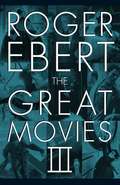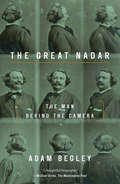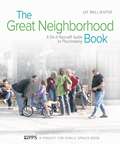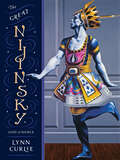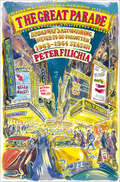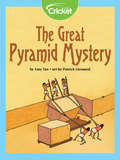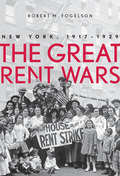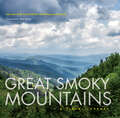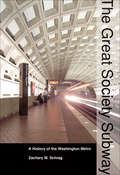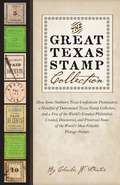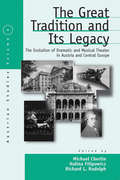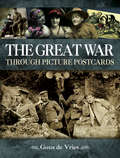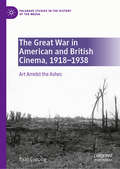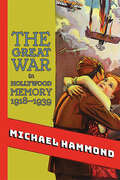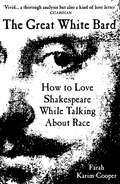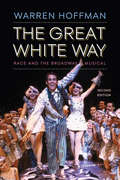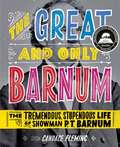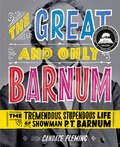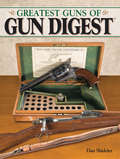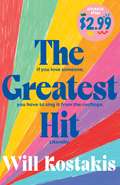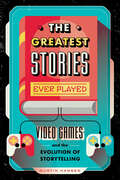- Table View
- List View
The Great Movies III
by Roger EbertRoger Ebert has been writing film reviews for the Chicago Sun-Times for over four decades now and his biweekly essays on great movies have been appearing there since 1996. As Ebert noted in the introduction to the first collection of those pieces, “They are not the greatest films of all time, because all lists of great movies are a foolish attempt to codify works which must stand alone. But it’s fair to say: If you want to take a tour of the landmarks of the first century of cinema, start here. Enter The Great Movies III, Ebert’s third collection of essays on the crème de la crème of the silver screen, each one a model of critical appreciation and a blend of love and analysis that will send readers back to the films with a fresh set of eyes and renewed enthusiasm—or maybe even lead to a first-time viewing. From The Godfather: Part II to Groundhog Day, from The Last Picture Show to Last Tango in Paris, the hundred pieces gathered here display a welcome balance between the familiar and the esoteric, spanning Hollywood blockbusters and hidden gems, independent works and foreign language films alike. Each essay draws on Ebert’s vast knowledge of the cinema, its fascinating history, and its breadth of techniques, introducing newcomers to some of the most exceptional movies ever made, while revealing new insights to connoisseurs as well. Named the most powerful pundit in America by Forbes magazine, and a winner of the Pulitzer Prize, Roger Ebert is inarguably the most prominent and influential authority on the cinema today. The Great Movies III is sure to please his many fans and further enhance his reputation as America’s most respected—and trusted—film critic.
The Great Movies IV
by Roger Ebert Matt Zoller Seitz Chaz EbertNo film critic has ever been as influential--or as beloved-- as Roger Ebert. Over more than four decades, he built a reputation writing reviews for the Chicago Sun-Times and, later, arguing onscreen with rival Chicago Tribune critic Gene Siskel and later Richard Roeper about the movies they loved and loathed. But Ebert went well beyond a mere "thumbs up" or "thumbs down." Readers could always sense the man behind the words, a man with interests beyond film and a lifetime's distilled wisdom about the larger world. Although the world lost one of its most important critics far too early, Ebert lives on in the minds of moviegoers today, who continually find themselves debating what he might have thought about a current movie. The Great Movies IV is the fourth--and final--collection of Roger Ebert's essays, comprising sixty-two reviews of films ranging from the silent era to the recent past. From films like The Cabinet of Caligari and Viridiana that have been considered canonical for decades to movies only recently recognized as masterpieces to Superman, The Big Lebowski, and Pink Floyd: The Wall, the pieces gathered here demonstrate the critical acumen seen in Ebert's daily reviews and the more reflective and wide-ranging considerations that the longer format allowed him to offer. Ebert's essays are joined here by an insightful foreword by film critic Matt Zoller Seitz, the current editor-in-chief of the official Roger Ebert website, and a touching introduction by Chaz Ebert. A fitting capstone to a truly remarkable career, The Great Movies IV will introduce newcomers to some of the most exceptional movies ever made, while revealing new insights to connoisseurs as well.
The Great Nadar: The Man Behind the Camera
by Adam BegleyA dazzling, stylish biography of a fabled Parisian photographer, adventurer, and pioneer.A recent French biography begins, Who doesn't know Nadar? In France, that's a rhetorical question. Of all of the legendary figures who thrived in mid-19th-century Paris—a cohort that includes Victor Hugo, Baudelaire, Gustave Courbet, and Alexandre Dumas—Nadar was perhaps the most innovative, the most restless, the most modern.The first great portrait photographer, a pioneering balloonist, the first person to take an aerial photograph, and the prime mover behind the first airmail service, Nadar was one of the original celebrity artist-entrepreneurs. A kind of 19th-century Andy Warhol, he knew everyone worth knowing and photographed them all, conferring on posterity psychologically compelling portraits of Manet, Sarah Bernhardt, Delacroix, Daumier and countless others—a priceless panorama of Parisian celebrity. Born Gaspard-Félix Tournachon, he adopted the pseudonym Nadar as a young bohemian, when he was a budding writer and cartoonist. Later he affixed the name Nadar to the façade of his opulent photographic studio in giant script, the illuminated letters ten feet tall, the whole sign fifty feet long, a garish red beacon on the boulevard. Nadar became known to all of Europe and even across the Atlantic when he launched "The Giant," a gas balloon the size of a twelve-story building, the largest of its time. With his daring exploits aboard his humongous balloon (including a catastrophic crash that made headlines around the world), he gave his friend Jules Verne the model for one of his most dynamic heroes. The Great Nadar is a brilliant, lavishly illustrated biography of a larger-than-life figure, a visionary whose outsized talent and canny self-promotion put him way ahead of his time.
The Great Neighborhood Book
by Jay Walljasper Project for Public SpacesAbandoned lots and litter-strewn pathways, or rows of green beans and pockets of wildflowers? Graffiti-marked walls and desolate bus stops, or shady refuges and comfortable seating? What transforms a dingy, inhospitable area into a dynamic gathering place? How do individuals take back their neighborhood?Neighborhoods decline when the people who live there lose their connection and no longer feel part of their community. Recapturing that sense of belonging and pride of place can be as simple as planting a civic garden or placing some benches in a park. The Great Neighborhood Book explains how most struggling communities can be revived, not by vast infusions of cash, not by government, but by the people who live there. The author addresses such challenges as traffic control, crime, comfort and safety, and developing economic vitality. Using a technique called "placemaking"--the process of transforming public space--this exciting guide offers inspiring real-life examples that show the magic that happens when individuals take small steps and motivate others to make change.This book will motivate not only neighborhood activists and concerned citizens but also urban planners, developers, and policymakers. Jay Walljasper is a senior fellow of Project for Public Spaces (PPS), whose mission is to create and sustain enriching public places that build communities. He is a former editor of The Utne Reader and currently executive editor of Ode magazine. Inspired by European cities, The Great Neighborhood Book highlights practical solutions for the revitalization of North American cities.
The Great Nijinsky: God of Dance
by Lynn CurleeA tragic story of a cultural icon—dance prodigy, sex symbol, LGBTQ+ pioneer—this compelling work of narrative nonfiction chronicles a life of obsessive artistry and celebrity of Vaslav Nijinsky. With one grand leap off the stage at the 1909 premiere of the Ballets Russes's inaugural season, Nijinsky became an overnight sensation and the century's first superstar, in the days before moving pictures brought popular culture to the masses. Perhaps the greatest dancer of the twentieth century, Nijinsky captured audiences with his sheer animal magnetism and incredible skill. He was also half of the most famous (and openly gay) couple of the Edwardian era: his relationship with Serge Diaghilev, artistic director and architect of the Ballets Russes, pushed boundaries in a time when homosexuality and bisexuality were rarely discussed. Nijinsky's life was tumultuous--after marrying a female groupie he hardly knew, he was kicked out of the Ballets Russes and placed under house arrest during World War I. Unable to work as he once did, his mental health deteriorated, and he spent three decades in and out of institutions.Biographical narrative is interspersed with spotlights on the ballets the dancer popularized: classic masterworks such as Afternoon of a Faun, The Firebird, and of course, the shockingly original Rite of Spring, which caused the audience to riot at its premiere. Illustrated with elegant, intimate portraits as well as archival art and photographs.
The Great Parade: Broadway's Astonishing, Never-to-Be-Forgotten 1963–1964 Season
by Peter FilichiaIt was the Broadway season when Barbra Streisand demanded "Don't Rain on My Parade" and Carol Channing heard the waiters at the Harmonia Gardens say "Hello, Dolly!". From June 1, 1963 through the final day of May 31, 1964, theatergoers were offered 68 different productions: 24 new plays, 15 new comedies, 14 new musicals, 5 revivals of plays, 3 revues, 3 plays in Yiddish, 2 in French, 1 double-bill and even 1 puppet show. Peter Filichia's The Great Parade will look at what a Broadway season looked like a half-century ago analyzing the hits, the flops, the trends, the surprises, the disappointments, the stars and even how the assassination of JFK and the arrival of the Beatles affected Broadway.The Great Parade is a chronicle of a Broadway season unprecedented in the star power onstage: Barbara Streisand, Carol Channing, Claudette Colbert. Colleen Dewhurst, Hal Holbrook, Mary Martin, Christopher Plummer, Robert Preston, Julie Harris, Jason Robards, Jr., Carol Burnett, Tallulah Bankhead, Alec Guinness, Kirk Douglas, Albert Finney, Paul Newman, Joanne Woodward, Richard Burton, Mary Martin, Beatrice Lillie, Hermione Gingold, Robert Redford and many more. Neil Simon and Stephen Sondheim burst on to the Broadway stage with Barefoot in the Park and Anyone Can Whistle. The '63-'64 season was one of Broadway's greatest and in The Great Parade, Peter Filichia gives us another classic.
The Great Pyramid Mystery
by Amy TaoNo one knows for sure just how the ancient Egyptians built the Great Pyramid of Giza, which is taller than the Statue of Liberty. How could an ancient civilization have achieved this engineering feat? Perhaps the solution to this mystery can be answered with simple machines!
The Great Radio Heroes
by Jim HarmonReminiscences of the heyday of radio programming, with insights on many of the favorite programs. Contains actor bios and more.
The Great Rent Wars
by Robert M. FogelsonWritten by one of the country’s foremost urban historians, The Great Rent Wars tells the fascinating but little-known story of the battles between landlords and tenants in the nation’s largest city from 1917 through 1929. These conflicts were triggered by the post-war housing shortage, which prompted landlords to raise rents, drove tenants to go on rent strikes, and spurred the state legislature, a conservative body dominated by upstate Republicans, to impose rent control in New York, a radical and unprecedented step that transformed landlord-tenant relations. The Great Rent Wars traces the tumultuous history of rent control in New York from its inception to its expiration as it unfolded in New York, Albany, and Washington, D. C. At the heart of this story are such memorable figures as Al Smith, Fiorello H. La Guardia, and Oliver Wendell Holmes, as well as a host of tenants, landlords, judges, and politicians who have long been forgotten. Fogelson also explores the heated debates over landlord-tenant law, housing policy, and other issues that are as controversial today as they were a century ago.
The Great Smoky Mountains: A Visual Journey
by Lee Mandrell Steve Kemp Deedee Niederhouse-MandrellThe Great Smoky Mountains have inspired, challenged, and entertained millions of visitors for hundreds of years.To preserve thesplendorof the mountains and valleys for all to enjoy, Franklin D. Roosevelt dedicatedthis beautiful area as a protected area and National Park in 1940. In this breathtaking book, the husband-and-wife photography team captures a new vision of the Great Smoky Mountains including both popular attractions and spectacular sites off the beaten path.Stunning photos represent all four seasons, including colorful fall foliage, spring's wildflower riches, intense summer sunsets, and serene winter snowfalls. Majestic views of mountains from Clingman's Dome to Morton Overlook along Newfound Gap Road will entice new visitors, while regulars will cherish the book as a memory album of their own, enjoying images of Cades Cove, Roaring Fork Motor Trail and the wildlife of the area. This book of new and remarkable photographs is a necessity for everyone who appreciates natural landscapes, wildlife, and beauty in an area rich with history and culture.
The Great Society Subway: A History of the Washington Metro (Creating the North American Landscape)
by Zachary M. SchragAs Metro stretches to Tysons Corner and beyond, this paperback edition features a new preface from the author.Drivers in the nation's capital face a host of hazards: high-speed traffic circles, presidential motorcades, jaywalking tourists, and bewildering signs that send unsuspecting motorists from the Lincoln Memorial into suburban Virginia in less than two minutes. And parking? Don't bet on it unless you're in the fast lane of the Capital Beltway during rush hour.Little wonder, then, that so many residents and visitors rely on the Washington Metro, the 106-mile rapid transit system that serves the District of Columbia and its inner suburbs. In the first comprehensive history of the Metro, Zachary M. Schrag tells the story of the Great Society Subway from its earliest rumblings to the present day, from Arlington to College Park, Eisenhower to Marion Barry. Unlike the pre–World War II rail systems of New York, Chicago, and Philadelphia, the Metro was built at a time when most American families already owned cars, and when most American cities had dedicated themselves to freeways, not subways. Why did the nation's capital take a different path? What were the consequences of that decision?Using extensive archival research as well as oral history, Schrag argues that the Metro can be understood only in the political context from which it was born: the Great Society liberalism of the Kennedy, Johnson, and Nixon administrations. The Metro emerged from a period when Americans believed in public investments suited to the grandeur and dignity of the world's richest nation. The Metro was built not merely to move commuters, but in the words of Lyndon Johnson, to create "a place where the city of man serves not only the needs of the body and the demands of commerce but the desire for beauty and the hunger for community."Schrag scrutinizes the project from its earliest days, including general planning, routes, station architecture, funding decisions, land-use impacts, and the behavior of Metro riders. The story of the Great Society Subway sheds light on the development of metropolitan Washington, postwar urban policy, and the promises and limits of rail transit in American cities.
The Great Texas Stamp Collection
by Charles W. DeatonAmong the many difficulties the newly formed Confederate States of America endured in the summer of 1861 was the failure of its post office department to provide sufficient numbers of that item most crucial to its service: the postage stamp. Faced with the resulting din of customer complaints, a handful of industrious Texas postmasters solved the problem by simply making their own homemade stamps. In this thoroughly researched history of these rare and highly coveted stamps, The Great Texas Stamp Collection traces their journey from creation through their rediscovery years later by local, and then international, stamp collectors-a journey that culminated in the sale of a few pieces at a recent auction in New York that fetched more than $250,000. Weaving the larger contexts of Texas and U. S. postal history together with individual tales of greed, intrigue, forgery, and discovery, Deaton's book is rich with characters from European royalty to early stamp dealers to common criminals, while also providing detailed examinations of the stamps themselves, including a complete census of the stamps now known as the Texas Confederate Postmasters' Provisionals. Appealing at once to devoted philatelists, Texas and U. S. history buffs, and amateur collectors of all kinds, The Great Texas Stamp Collection offers a unique vantage point from which to view our history as well as the very nature of collecting.
The Great Tradition And Its Legacy
by Michael Cherlin Richard L. Rudolph Halina FilipowiczBoth dramatic and musical theater are part of the tradition that has made Austria - especially Vienna - and the old Habsburg lands synonymous with high culture in Central Europe. Many works, often controversial originally but now considered as classics, are still performed regularly in Vienna, Prague, Budapest, or Krakow. This volume not only offers an excellent overview of the theatrical history of the region, it is also an innovative, cross-disciplinary attempt to analyse the inner workings and dynamics of theater through a discussion of the interplay between society, the audience, and performing artists.
The Great Wall Through Time: A 2,700-Year Journey Along the World's Greatest Wall (DK Panorama)
by DKTravel through time on an exhilarating expedition to China&’s most famous landmark!The Great Wall of China is one of the world&’s most intriguing, well-known treasures. Spanning 2,700 years and over 13,000 miles long, embark on the fascinating tale of how the Great Wall was built and how it became one of the greatest man-made projects of all time.This thrilling children&’s book about this fascinating structure will leave you with newfound knowledge and appreciation for this amazing world wonder. It includes: • Exquisitely detailed panoramic artworks that show how the Great Wall of China has changed from one era to the next — from the first defensive forts created in 656 BCE to the 13,000 mile-long monument still standing today • Cutaway views that reveal the interior of forts and buildings • Every illustration is surrounded by pull-out details for children to look at, drawing them into the picture and making the book fun and interactive • Lively, engaging narrative text and simple annotations that guide children on a journey through time This informative book educates young readers about how the Great Wall was built and showcases the people that help build it. The wall, one of the new Seven Wonders of the World, started as a frontier defense against northern tribesmen and over the eras evolved to become the dynamic landmark that it is today.This educational history book also contains exceptional cutaway views revealing the interiors of important buildings, and pull-out details introducing fascinating facts and key characters. The time-traveling fox who appears in the artwork will have children inquisitively searching for the charming fox throughout the book.This makes for the perfect gift or collector&’s item for children age 7 and up to learn about the Great Wall of China and its history. It is also perfect for parents looking for books on Chinese history to read with their children, and those planning on visiting the Great Wall of China who want to learn more about the landmark before or after their trip.
The Great War Through Picture Postcards
by Guus de VriesDuring World War I, the picture postcard was the most important means of communication for the soldiers in the field and their loved ones at home, with an estimated 30 billion of them sent between 1914 and 1918. A Postcard from home offered the soldier in the trenches a short escape from their daily hell, while receiving a postcard from the man on the front-line was literally a sign of life. These postcards create a vivid record of life at home and abroad during the Great War, both from the messages they carries and the pictures on the cards themselves. The dipiction of war on the contemporary postcards is extremely diverse: The ways in which the postcards depict the war differs greatly; from simple enthusiasm, patriotism and propaganda to humour, satire and bitter hatred. Other portray the wishes and dreams (nostalgia, homesickness and pin-ups) of the soldiers, the technological developments of the armies, not to mention the daily life and death on the battlefield, including the horrific reality of piles of bodied and mass-graves Altogether, this extraordinarily vivid contemporary record of the Great War offers a unique and details insight on the minds and mentality of the soldiers and their families who lived and died in the war to end all wars.
The Great War in American and British Cinema, 1918–1938: Art Amidst the Ashes (Palgrave Studies in the History of the Media)
by Ryan CoppingThis book recounts the reception of selected films about the Great War released between 1918 and 1938 in the USA and Great Britain. It discusses the role that popular cinema played in forming and reflecting public opinion about the War and its political and cultural aftermath in both countries. Although the centenary has produced a wide number of studies on the memorialisation of the Great War in Britain and to a lesser degree the USA, none of them focused on audience reception in relation to the Anglo-American ‘circulatory system’ of Trans-Atlantic culture.
The Great War in Hollywood Memory, 1918-1939 (SUNY series, Horizons of Cinema)
by Michael HammondThis is the definitive account of how America's film industry remembered and reimagined World War I from the Armistice in 1918 to the outbreak of World War II in 1939. Based on detailed archival research, Michael Hammond shows how the war and the sociocultural changes it brought made their way into cinematic stories and images. He traces the development of the war's memory in films dealing with combat on the ground and in the air, the role of women behind the lines, returning veterans, and through the social problem and horror genres. Hammond first examines movies that dealt directly with the war and the men and women who experienced it. He then turns to the consequences of the war as they played out across a range of films, some only tangentially related to the conflict itself. Hammond finds that the Great War acted as a storehouse of motifs and tropes drawn upon in the service of an industry actively seeking to deliver clearly told, entertaining stories to paying audiences. Films analyzed include The Big Parade, Grand Hotel, Hell's Angels, The Black Cat, and Wings. Drawing on production records, set designs, personal accounts, and the advertising and reception of key films, the book offers unique insight into a cinematic remembering that was a product of the studio system as it emerged as a global entertainment industry.
The Great White Bard: How to Love Shakespeare While Talking About Race
by Farah Karim-CooperSHAKESPEARE: increasingly irrelevant or lone literary genius of the Western canon?'Powerful and illuminating' James Shapiro, author of 1599: A Year in the Life of William Shakespeare, winner of the Baillie Gifford 'Winner of Winners' 2023 Professor Farah Karim-Cooper grew up loving the Bard, perhaps because Romeo and Juliet felt Pakistani to her. But why was being white as a &‘snowy dove&’ essential to Juliet&’s beauty? Combining piercing analysis of race, gender and otherness in beloved plays from Othello to The Tempest with a radical reappraisal of Elizabethan London, The Great White Bard entreats us neither to idealise nor to fossilise Shakespeare but instead to look him in the eye and reckon with the discomforts of his plays, playhouses and society. If we persist in reading Shakespeare as representative of only one group, as the very pinnacle of the white Western canon, then he will truly be in peril. But if we dare to bring Shakespeare down from his plinth, we might unveil a playwright for the twenty-first century. We might expand and enrich his extraordinary legacy. We might even fall in love with him all over again. *** A TIME MAGAZINE BOOK OF THE YEAR 2023 'Insightful, passionate, piled with facts and has a warm, infectious love for theatre and Shakespeare running through every chapter.' ADRIAN LESTER, CBE 'Dive in and your whole cultural landscape will be refreshed and reframed... A challenging, riveting read, The Great White Bard reminds us how powerful the stories we tell can be on our lives.' ADJOA ANDOH 'Vivid… a thorough analysis but also a kind of love letter… Karim-Cooper sees Shakespeare as holding a mirror to this society, with his plays interrogating live issues around race, identity and the colonial enterprise… Her arguments come to feel essential and should be absorbed by every theatre director, writer, critic, interested in finding new ways into the work.&’ GUARDIAN 'There are plenty of books on Shakespeare: but this one is different. This is Shakespeare as we&’ve (most of us) never been willing to see him – and the works emerge from the analysis as newly complicit, powerful and yet recuperative.' EMMA SMITH, AUTHOR OF PORTABLE MAGIC
The Great White Shark Scientist (Scientists in the Field Series)
by Sy Montgomery Keith Ellenbogen<P>Dr. Greg Skomal, biologist and head of the Massachusetts Shark Research Program, is investigating a controversial possibility: Might Cape Cod's waters serve as a breeding ground for the great white shark, the largest and most feared predatory fish on Earth? <P>Sy Montgomery and Keith Ellenbogen report on this thrilling turning point in marine research and travel to Guadeloupe, Mexico, to get up close and personal with the sharks. This daring expedition into the realm of great whites shows readers that in order to save the planet and its creatures, we must embrace our humanity and face our greatest fears. <P><b>Winner of the 2018 Riverby Award</b>
The Great White Way: Race and the Broadway Musical
by Warren HoffmanBroadway musicals are one of America’s most beloved art forms and play to millions of people each year. But what do these shows, which are often thought to be just frothy entertainment, really have to say about our country and who we are as a nation? Now in a new second edition, The Great White Way is the first book to reveal the racial politics, content, and subtexts that have haunted musicals for almost one hundred years from Show Boat (1927) to Hamilton (2015). This revised edition includes a new introduction and conclusion, updated chapters, as well as a brand-new chapter that looks at the blockbuster musicals The Book of Mormon and Hamilton. Musicals mirror their time periods and reflect the political and social issues of their day. Warren Hoffman investigates the thematic content of the Broadway musical and considers how musicals work on a structural level, allowing them to simultaneously present and hide their racial agendas in plain view of their audiences. While the musical is informed by the cultural contributions of African Americans and Jewish immigrants, Hoffman argues that ultimately the history of the American musical is the history of white identity in the United States. Presented chronologically, The Great White Way shows how perceptions of race altered over time and how musicals dealt with those changes. Hoffman focuses first on shows leading up to and comprising the Golden Age of Broadway (1927–1960s), then turns his attention to the revivals and nostalgic vehicles that defined the final quarter of the twentieth century. He offers entirely new and surprising takes on shows from the American musical canon—Show Boat (1927), Oklahoma! (1943), Annie Get Your Gun (1946), The Music Man (1957), West Side Story (1957), A Chorus Line (1975), and 42nd Street (1980), among others. In addition to a new chapter on Hamilton and The Book of Mormon, this revised edition brings The Great White Way fully into the twenty-first century with an examination of jukebox musicals and the role of off-Broadway and regional theaters in the development of the American musical. New archival research on the creators who produced and wrote these shows, including Leonard Bernstein, Jerome Robbins, Stephen Sondheim, and Edward Kleban, will have theater fans and scholars rethinking forever how they view this popular American entertainment.
The Great and Only Barnum: The Tremendous, Stupendous Life of Showman P. T. Barnum
by Candace FlemingThe life of showman Phineas Taylor Barnum gets show-stopping treatment in Fleming's latest biographical work. Presented as clever, resilient and ever-consumed with making a buck, the Barnum of the Ringling Bros. and Barnum & Bailey Circus is brought to life in anecdotes over 11 chapters. Nicknamed Tale as a boy, he hated farmwork (I was always ready to concoct fun, or lay plans for money-making, but hand-work was decidedly not in my line). His personal struggles with alcohol and a less-than-happy marriage are detailed alongside his many public successes (and hoaxes). A tour of his famed American Museum and an account of a day at the circus (complete with descriptions of the human curiosities Barnum employed) set readers in the middle of the singular late 19th-century entertainment scene. As in a real circus, the large-format pages include plenty to grab readers' attention: white-on-black sidebars that put the entrepreneur's feats in context (African Americans were barred from entering Barnum's American Museum except on certain days), bw photos and advertising posters. Audiences will step right up to this illuminating and thorough portrait of an entertainment legend. Ages 8-12. Copyright Reed Business Information, a division of Reed Elsevier Inc. All rights reserved.
The Great and Only Barnum: The Tremendous, Stupendous Life of Showman P. T. Barnum
by Candace FlemingDiscover the true story of P.T. Barnum, the man who created the world-famous Barnum & Bailey Circus, as featured in the movie The Greatest Showman! The award-winning author of The Lincolns: A Scrapbook Look at Abraham and Mary, Amelia Lost, and Our Eleanor brings us the larger-than-life biography of showman P. T. Barnum. Known far and wide for his jumbo elephants, midgets, and three-ring circuses, here&’ s a complete and captivating look at the man behind the Greatest Show on Earth. Readers can visit Barnum&’s American Museum; meet Tom Thumb, the miniature man (only 39 inches tall) and his tinier bride (32 inches); experience the thrill Barnum must have felt when, at age 60, he joined the circus; and discover Barnum&’s legacy to the 19th century and beyond. Drawing on old circus posters, photographs, etchings, ticket stubs—and with incredible decorative art by Ray Fenwick—this book presents history as it&’s never been experienced before—a show-stopping event!
The Greatest Guns of Gun Digest
by Dan ShidelerThe Greatest Gun Book of All Time Presents – The Greatest Guns of All Time! In The Greatest Guns of Gun Digest®! For over six decades, Gun Digest has been the definitive guide to the world's greatest guns. Pistol and revolvers, rifles and shotguns, military and commercial arms – all have been lovingly and lavishly featured in the pages of the world's greatest firearms annual, Gun Digest. Now you can read the most detailed, most information-packed feature stories dealing with the world's greatest guns in one handy, entertaining volume. Compiled from 67 years of Gun Digest archives, The Greatest Guns of Gun Digest presents the most significant guns of all time, includingPaterson and Walker ColtsThe Luger PistolThe .44 Magnum. . .One Year Later (S&W M29)Remington's XP-10045 Auto PistolThe Extraordinary GlockCollecting Old WinchestersWorld's Most Powerful RifleThe Model 70 WinchesterThe Winchester Model 94Those Plastic Remingtons (Nylon 66)Battle of the Automatics (Browning Double Auto/JC Higgins Model 60)The Darne GunWinchester Model 42The Thompson SubmachinegunThe 1903 SpringfieldThe M16A2 For the collector, for the shooter, for the fan of classic and special-interest guns, there's no other volume like The Greatest Guns of Gun Digest. It's a must-have addition to any shooter's library!
The Greatest Hit: Australia Reads Special Edition
by Will KostakisPeople look at Tessa and see her biggest mistake.While everyone else her age is taking their bold first steps into adulthood, she's just trying to outrun a song that went viral when she was fourteen.But now - an opportunity. A profile as one of The Five Most Forgettable Internet Celebrities of the Decade So Far gives her the chance to right a wrong, and the courage to sing her greatest hit as it was originally written. But will it be enough to win back the person she hurt?A touching new story from one of Australia's leading YA writers.
The Greatest Stories Ever Played: Video Games and the Evolution of Storytelling (Game On #2)
by Dustin HansenIn this fun and informative YA Non-fiction title, Dustin Hansen, author of Game On!, a self-confessed video game addict with over 20-years experience in the gaming industry, examines the storytelling skills shown in some of the most beloved and moving games of all time.We all know that video games are fun, but can a video game make you cry? Can it tell you a powerful love story? Can a video game make you think differently about war? About the environment? About the choices you make?Whether it's playing through blockbuster-esque adventures (Uncharted, God of War, The Last of Us), diving deep into hidden bits of story and lore (Red Dead Redemption II, Bioshock, Journey) or building relationships that change the fate of the world itself (Persona 5, Undertale), video games are bringing stories to life in ways that are immediate, interactive and immersive. Focusing on some of the best, most memorable, experiences in gaming, The Greatest Stories Ever Played, examines the relationship between gaming and storytelling in a new way.
